JUMP CUT
A
REVIEW OF CONTEMPORARY MEDIA
![]()

10. From Painful Deceptions: the unusual configurations of WTC explosions

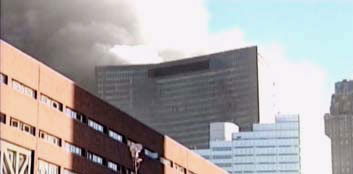
11. The strangest anomaly: the collapse of Building 7


12. Like a sci-fi monster pursuing a crowd: the dust storm said to be unique to demolition


13. Not made of cardboard: the WTC under construction in 1969


14. Molten metal pouring from the WTC? From 9/11 Mysteries

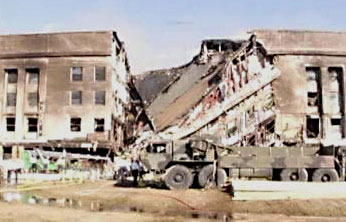
15. Destruction to the Pentagon


16. Evidence of an airliner crash?

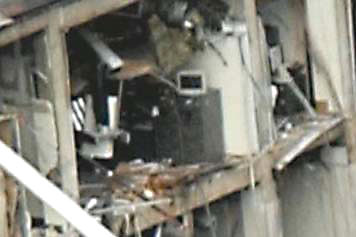
17. Inside Pentagon crash site: an inferno raged here?

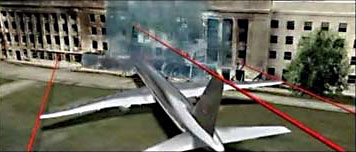
18. Investigation in the CGI ages: flightpath of Flight 77 in Painful Deceptions


19. Some exterior Pentagon images may indeed point to airliner crash.

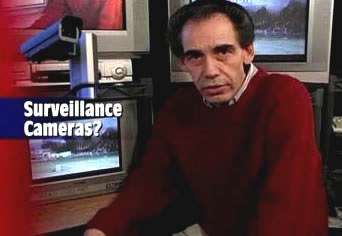
20. Dave von Kleist hosting In Plane Site: the bank of monitors adds a touch of authenticity.


21. von Kleist as pedagogue: "pods" under plane?


22. Barrie Zwicker's "news special": a satiric jab at the media

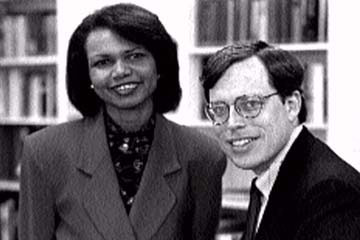
23. Condeleeza Rice and Philip Zelikow



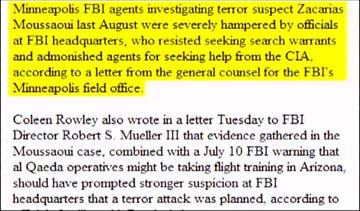
25. Fragment of FBI agent Coleen Rowley's angry complaint: "Minneapolis FBI agents investigating suspect Zacarias Moussaoui last August were severely hampered by officials at FBI headqarters, who resisted seeking search warrants and admonished agents for seeking help from the CIA, according to a letter from the general counsel for the FBI's Minneapolis field office.


26. George W. Bush and Chief of Staff Andrew Card at Florida grammer school on 9/11: an emblematic moment

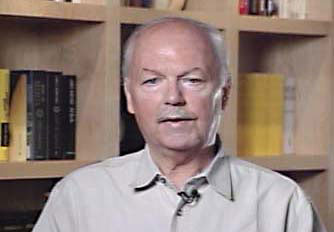
27. James Bamford, author of Body of Secrets

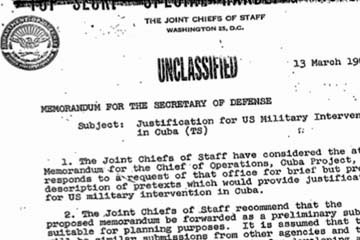
28. First page of 1962 Operation Northwoods documents: the Joint Chiefs of Staff Memorandum to Secretary of Defense with "description of pretexts which would provide justification for US military intervention in Cuba"

Avery points out that the two towers collapsed straight down in freefall, within a matter of seconds, landing in their “footprints” (foundations), a physically impossible act barring the intervention of explosive charges, according to physicist Steven Jones and a slowly emerging group of scientists interested in this case. Avery highlights in newsclips a number of explosions in the form of jets of debris (said by Movement opponents to be merely the result of air pressure) emanating from lower floors of the towers as the buildings start to come down, creating huge clouds of dust much larger than the (Fig. 10) circumference of each tower, as pieces of steel beams are thrown upward and outward at great velocity. The video includes comments from on-scene witnesses, firefighters, and local and national newspersons, who mention secondary explosions in the towers after the airplanes crash, and the resemblance of the collapse of both towers to controlled demolition, an idea that was set aside in later news commentary. In one segment taken from a documentary by the Naudet brothers, French filmmakers chronicling the New York Fire Department, we see a group of firemen just returned from the site, discussing in some detail the demolition-like features of the collapse. One firefighter chops at the air with his hand to simulate the staggered nature of the collapse as each floor of one tower came down on another in a manner reminiscent of demolition.
Both Avery and Eric Hufschmid (Hufschmid’s video is Painful Deceptions: an Analysis of the September 11th Attack) cite a PBS documentary entitled America Rebuilds, featuring a brief interview with Larry Silverstein, billionaire leaseholder on the WTC complex (although built with public revenue, it became private property). Incredibly, Silverstein remarks that he ordered Building 7 of the complex “pulled.” The (Fig. 11) building collapsed late in the day although it was not hit by an airplane. Silverstein says he ordered Building 7 “pulled” since he feared further loss of life (one can only speculate on his reasoning — the area had been cleared of employees and onlookers). “Pull” is industry shorthand for controlled demolition. The collapse of Building 7 some distance from the twin towers is one of the most vexing issues of that day. The Federal Emergency Management Agency (FEMA) could come to no conclusion as to its collapse, its lackadaisical verdict a shameful insult to taxpayers, and far more importantly 9/11 victims. Like the twin towers, Building 7 collapsed in freefall, creating an enormous dust storm caused by concrete, furniture, carpets, and office equipment pulverized into (Fig. 12) micron-sized powder, forming an environmental nightmare that wrecked the health of rescue workers. For Avery and Hufschmid (supported by the science of Steven Jones), the transformation of all the WTC concrete into fine dust is an indicator of demolition. The huge pyroclastic cloud, seen in any number of photos of the WTC collapse, is exclusive to natural phenomena such as volcano eruptions, or to demolitions in which powerful charges create sudden, rapidly-propelled storms of fine dust.
The Building 7 skyscraper was damaged on one part of its façade and had only a few small, widely spaced fires. It seemed not to threaten its surroundings. Avery states that Building 7 headquartered several U.S. intelligence agencies, and was a command center for New York Mayor Rudolph Guiliani. Loose Change speculates that Building 7 may have played a role in routing the hijacked planes to their destinations. Avery notes that Silverstein took out a billion-dollar insurance policy on the complex that specifically covered terrorism. (In a recent press release, Silverstein states that he used the term “pull” to refer to evacuation of rescue teams, an unlikely usage in context.) Quick financial gain by a number of people may have been the proximate reason for 9/11, countering arguments that the attacks were extremely costly to finance capital and large sectors of the U.S. economy. Certainly the ensuing wars on Iraq and Afghanistan were the larger payoff to state and private power. The ultimate function of the attacks is best summarized in the title of James Bamford’s book, A Pretext for War.
Avery and author David Griffin have been countered by various proponents of the official narrative, ranging from Popular Mechanics to a Nova documentary. The debunkers argue that the buildings’ floors buckled and melted under the extreme heat caused by the jet fuel of the crashed planes, the towers then “pancaking,” meaning that one floor would simply collapse upon another, creating a chain reaction until all floors ended up at the foundation like a stack of pancakes or phonograph records. Backpedaling on this theme, more recent defenders of the official narrative hold that joints of the building snapped — in unison it seems — under the weight of the airplane fragments. The Nova film and a similar History Channel documentary also note that the towers were improperly built, with insufficient vertical support to each floor. Kickbacks, construction shortcuts, and corruption need to be considered, but the idea that the WTC towers were made virtually of tissue paper seems a strained defense. Loose Change and Painful Deceptions argue, with the help of compelling period footage of the WTC construction, that both towers had massive vertical steel cores making them engineering marvels, (Fig. 13) designed to withstand major hurricanes — and airplane crashes. After all, the WTC was built in close proximity to three major airports. To rebut the claim that the steel joints of the buildings simply melted, Avery and Hufshmid note that the kerosene-based jet fuel of the two hijacked planes mostly burned off at the time of impact, and it never burned hot enough (blast furnace temperature would be required) or nearly long enough to melt steel. They further argue, again with documentary footage and examination of the historical record, that no steel-frame skyscraper has ever collapsed from fire, even buildings totally (Fig. 14) consumed in flames for several days. They observe that satellite imaging detected molten metal in the WTC foundations long after the attacks, even after rainstorms and firefighters pouring water on the debris. This highly unusual liquid steel could be the result of super-hot explosive charges whose heat had nowhere to go.
One difficulty with the documentarians’ view of the WTC destruction as controlled demolition is their failure to offer a thesis as to why this particular form of terror would be undertaken. One can see how the total collapse of the buildings created an alarming “shock and awe” spectacle, but couldn’t the planners simply load the jets with high explosives that would accomplish the same effect? Sorting through each and every aspect of the mechanics of the attacks may be fruitless; that such an event could be accomplished as an act of state terror is plain enough with the discovery of the Operation Northwoods documents, about which more below. And it would seem reasonable at this stage to place the burden of proof on state authority in any case.
Avery and Hufschmid also discuss the assault of Flight 77 on the Pentagon. Both documentarians note that the hole in one side of the building (a side that was under renovations, largely empty, and far away from the offices of Pentagon officials like Donald Rumsfeld) was far too small to represent the impact of a Boeing 767 jetliner. (Fig. 15) More important, the plane, if it did strike the building, seems to have vaporized entirely, leaving no fuselage, engines, seats, or luggage. Some miscellaneous small debris was found far outside the building. The notion that the heat of the explosion consumed the plane entirely has no historical precedent, and in this context seems especially risible.
In news footage included in Loose Change and Painful Deceptions, we can see the interior floors of the Pentagon that directly abut the crash site; furniture, books, and paper products sit totally unscathed by what could only have been a raging inferno. There are no skid marks on the large lawn outside the building, although Flight 77 is said to have (Fig. 16) traveled virtually at ground level in its attack on the building, a nearly impossible feat, according to Avery. The plane descended suddenly from a high altitude, circled the Pentagon, and crossed a freeway system without striking vehicles or knocking over a webwork of lampposts. The plane was supposedly piloted by Hani Hanjour, who showed little or no flying ability at the U.S. flight schools where he put in appearances. Although some witnesses to the Pentagon crash said they saw a jet airliner, others reported a much smaller plane — Avery and Hufschmid argue that it was a military drone aircraft. In one of his famous offhand remarks following the attacks, Donald Rumsfeld uses the word missile in relation to the Pentagon attack.
(Fig. 17) (Fig. 18) Although the Pentagon has a complex missile defense system, it, like so much else, seems to have gone on vacation on 9/11. This is likewise true of video surveillance footage. Only one of the Pentagon’s video cameras seems to have worked that day — five frames of the explosion taken by this camera were released for publication. All other cameras, including those at nearby hotels and gas stations, had nothing to offer. In order to quell conspiracy mongering, in the spring of 2006 the Pentagon released a few more frames from the aforementioned single camera, showing what is supposed to be the crash of Flight 77. A silver-white object can be seen coming in from the right side of the frame, but the footage itself is too indistinct to permit identification of the craft, at least to my eyes. This footage seems to have drawn little or no interest, disappearing from the network news and daily press after a day. In his Sept. 25 Nation article, Alexander Cockburn says that his brother Andrew has seen photos “taken within thirty minutes of impact, clearly showing the outline of an entire plane.” (We may need to set Cockburn aside for a bit, since he is emerging as a professional curmudgeon — see his recent diatribes against climate change arguments in recent [no surprise] issues of The Nation.) There are indeed some photographs of the Pentagon’s damaged façade taken within moments of the crash. A few are so smoke-filled that the damage outline is indistinct, but (Fig. 19) ongoing research, including interviews with numerous witnesses, tends to support the idea that the building was most likely hit by a jetliner. Researcher Jim Hoffman has published extensive work on the Pentagon crash on his online site. Using engineering skills, Hoffman argues that the notion of a missile assault to the Pentagon is poppycock, that there is in fact evidence of crash debris in the building, but that the radical arc and rapid descent of Flight 77 suggests either a tremendously skilled pilot or a plane commanded by remote control. Still, one wonders why so few images of the actual assault are available considering the number of cameras at or near the building.
The work of Hoffman and others with scientific credentials is crucial, as more DVDs flood the market and set the terms of argument. As one listens to Avery’s assured, know-it-all youthful enthusiasm, his presentation, for all its multimedia acumen, raises as many questions as it answers. Most of the facts and figures he cites seem incontestable, but some areas are very much open to interpretation. And viewers may ask if he and others in the Truth Movement know whereof they speak as they get into chemistry and physics. With their freewheeling populist attitude toward disseminating knowledge in the age of new copyright roadblocks, some 9/11 videographers commit the student error of merely repeating (plagiarizing?) uncritically what others have already said.
(Fig. 20) The video 9/11: In Plane Site (could there be a more awful title?) emphasizes a detail of the WTC attacks. Assembled by Dave von Kleist, the host of something called The Power Hour, the video notes a flash that appears in front of the noses of both of the planes that hit the twin towers. Seated in a control room in front of monitors, the sweater-clad, slightly smarmy von Kleist, a kind of Mr. Rogers of the Movement, asks the viewer’s forbearance as he scrutinizes details of the hijacked airliners. According to von Kleist, the flashes are inconsistent with reflections or static electricity. Von Kleist also says that a long bulbous object appears on the underbellies of the planes that hit the (Fig. 21) north and south towers, and that the plane that hit the south tower is very dark, resembling neither an American Airlines nor a United Airlines jet. Witnesses cited in the video remark that the plane that hit the south tower appeared to have no windows. Von Kleist argues that these planes, like the one that hit the Pentagon, were military drone (or “robot”) aircraft. Military experts responding to the notion that the hijacked airliners were drones state that it would be unnecessary for the planes to have visible nodules to permit their control by remote computer. Jim Hoffman and other researchers have taken von Kleist to task for the non-science he uses to make his points. Hoffman’s research persuasively demonstrates that the “pods” von Kleist sees are merely protrusions of the craft’s undercarriage. Worse, the images in In Plane Site are so grainy and indistinct, it would be irresponsible even to venture a guess as to what they represent. Von Kleist’s use of a few witnesses who claim to have seen a black, windowless plane strike the WTC seems equally specious. Wouldn't the plotters take the time to make the aircraft at least look like a commercial airliner rather than make their plans so screamingly obvious?
(Fig. 22) The dynamics of the actual attacks are only one point of interest in the 9/11 videos. Barrie Zwicker’s The Great Conspiracy: The 9/11 News Special You Never Saw, is burdened by an annoying news magazine format that is mostly parodical, with Zwicker seated at a long desk with a monitor at his right elbow. Zwicker, a progressive who writes for the Ontario-based magazine Global Outlook, is an articulate analyst of the event's political and historical context, as well as some of the phenomena that led up to and followed the attacks. In contrast to the breathless, wide-eyed, or studiously serious delivery of some of the researcher/ documentarians, Zwicker is sober and mature, with a small touch of sarcasm. One of his crucial concerns is the cover-up by the 9/11 Commission, whose very creation Bush opposed until his adamancy became too telling — he in fact opposed any inquiry into 9/11. The Commission wasn’t instituted until over a year and a half after the event, and then with Henry Kissinger (the tale suffers in the telling) as its director. Kissinger promptly stepped down after public uproar. Zwicker remarks that the two subsequent co-chairs of the Commission, former New Jersey Republican Governor Thomas Kean, and former congressman Lee Hamilton, had numerous conflicts of interests. Hamilton, a Democrat (the bi-partisan nature of the Commission was meant to ensure its independence, the familiar song of so-called blue-ribbon panels) is famous for his inability to assign blame in any investigation in which he held a key role, including the October Surprise and Iran-Contra inquiries.
(Fig. 23) The Commission’s staff director, Zwicker notes, was Philip Zelikow, a rightist ideologue associated with the notorious neoconservative think tank, the Project for The New American Century. Zelikow also served on the Bush-Cheney transition team. Zwicker is so right to smirk at the notion of this commission’s independence, particularly when Bush and Cheney appeared before it on the stipulation that they do so together, with no record of their testimony, guaranteeing its relegation to the dustbin of history. (Note: in their recent insider memoir of the investigation, Without Precedent, Kean and Hamilton are so much on the inside they let little get outside, including what Bush and Cheney had to say.)
Zwicker is incensed at the Commission’s assertions that the U.S. had no foreknowledge of 9/11, and his newsmagazine guests cite accounts that authorities not only had foreknowledge, but hindered efforts to stop the attacks. On June 3, 2002, Time published a famous (now largely forgotten) memo from former FBI officer Coleen Rowley, (Fig. 24) expressing anger over her superior’s deliberate thwarting of the investigation of Zacarias Moussaoui, the so-called “twentieth hijacker” (Moussaoui, a manifestly incompetent man, was convicted in 2006 and sentenced to life in prison). The urgency and rage of Rowley’s language are deleted from the 9/11 Commission Report. Zwicker warns that certain official outrage might be a diversion, making us fixate on individuals who may be scapegoats in the 9/11 plots.
(Fig. 25) The Great Conspiracy also lambasts the 9/11 Commission by taking up the failure of the North American Aerospace Defense Command (NORAD) to intercept the hijacked planes. Contrary to the Commission’s assertion that government suffered a “failure of imagination” and that NORAD was designed only for Cold War purposes (meaning, it seems, that taxpayers have been flushing billions down the toilet since the collapse of the Soviet state), Zwicker and numerous 9/11 videos note that the Air Force routinely intercepts off-course airliners, 67 times in the year prior to 9/11 alone. Zwicker plays a famous ho-hum conversation between an FAA controller and the agency’s command center. Personnel seem drastically low on blood glucose, expressing near-total indifference as to whether or not jets should be scrambled as the 9/11 crisis unfolded. One can never underestimate incompetence, but, as Zwicker and David Griffin note, this particular pandemic incompetence seems to have been unique to 9/11.
Zwicker is very acute in his analysis of the Bush non-response to the attacks, preferring to stick with his photo-op at a Florida schoolhouse. Bush and colleagues (Fig. 26) seemed remarkably unconcerned about the events in New York. One would think that the Presidential security forces had to assume they might themselves have been targeted by the terrorists, yet Bush saw no reason to excuse himself from the schoolchildren and tend to more pressing matters. Michael Moore’s use of this sequence is one of the most shocking and dramatic moments of Fahrenheit 9/11. U.S. foreknowledge of the 9/11 attacks is a huge substratum of research represented in Zwicker and the best of the 9/11 videos, especially the paper-trail-oriented Everybody’s Gotta Learn Sometime. Topic areas range from Condoleeza Rice’s obvious dissembling about “no one being able to imagine” the use of jetliners as weapons of mass destruction (although the Pentagon conducted defense drills precisely on this danger), to Project Able Danger, a Defense Intelligence Agency operation monitoring — and apparently protecting — al Qaeda members in the U.S., including so-called ringleader Mohamed Atta.
Zwicker is especially concerned with the topic of historical context, an interest he shares with Michael Ruppert’s video The Truth and Lies of 9/11, and Ralph Schoenman’s The Underlying Politics of 9/11, as well as Richard Sanders’s 9/11 and Historical War Pretext Incidents — the latter two taped lectures were recorded at the May, 2004 International Inquiry into 9/11 in Toronto. Zwicker remarks that if 9/11 wasn’t a staged event designed to raise war fever, it is an exception to the rule. Zwicker, Ruppert, Schoenman, and Sanders examine, with varying degrees of emphasis, the way the U.S. government has used contrived, provocative incidents since the Nueces Strip affair that gave the U.S. pretext for the Mexican War. Historical precedents such as the sinking of the battleship Maine as a pretext for the Spanish-American War, U.S. foreknowledge of the Pearl Harbor attack, and the fabricated Tonkin Gulf episode are all relevant “false flag” operations (crimes planned by one nation but blamed on other nations or groups) that Zwicker and the more historically focused 9/11 researchers discuss.
(Fig. 27) Among the more chilling pieces of information that came into the public domain as the Truth Movement was conceived is Operation Northwoods, a 1962 Pentagon project seems the model of current false flag operations — it is discussed in Zwicker and numerous 9/11 (Fig. 28) DVDs. Revealed by former ABC producer James Bamford in his book Body of Secrets: Inside the Ultrasecret National Security Agency, the post-Missile-Crisis Northwoods plan, approved and put at the ready by the entire Joint Chiefs of Staff but nixed by (Fig. 29) (Fig. 30) Defense Secretary Robert McNamara and President Kennedy, called for the hijacking and destruction of commercial airliners (in fact making use of substitute aircraft whose (Fig. 31) (Fig. 32) passengers would be intelligence functionaries), the random killing of U.S. citizens, and the blowing up of John Glenn’s NASA rocket, all to be ascribed to Castro’s Cuba with the intention of raising public furor and justifying a second attempt to invade Cuba—in fact, the the declassified Northwoods documents cite the usefulness of the sinking of the Maine to state interests.
29. Gen. Lyman Lemnitzer, Chairman of the Joint Chiefs of Staff and architect of the Northwoods Project |
30. "Codename Operation Northwoods: called for various false flag actions, including simulated or real state sponsored terrorism on U.S. and Cuban soil.” Model for the current age? |
31. John F. Kennedy: his assassination is still a keysone for study of state crisis. |
|
To
top![]() Print
version
Print
version![]() JC 50
JC 50 ![]() Jump
Cut home
Jump
Cut home

This work is licensed under a Creative Commons Attribution-NonCommercial-NoDerivs 2.5 License.



